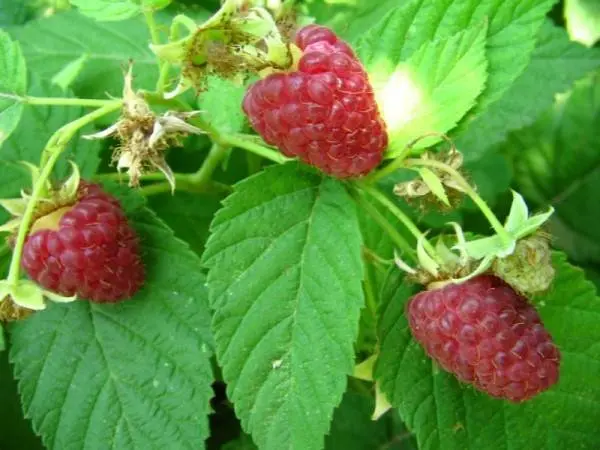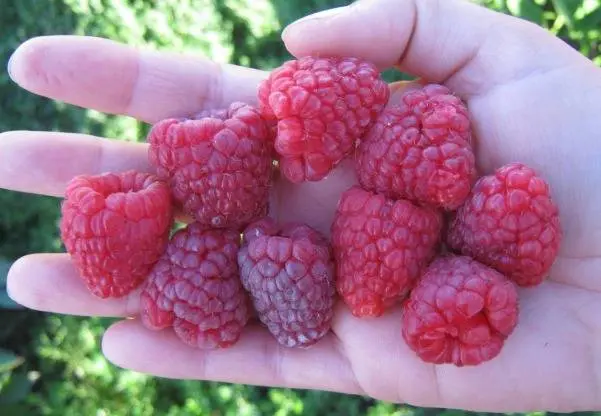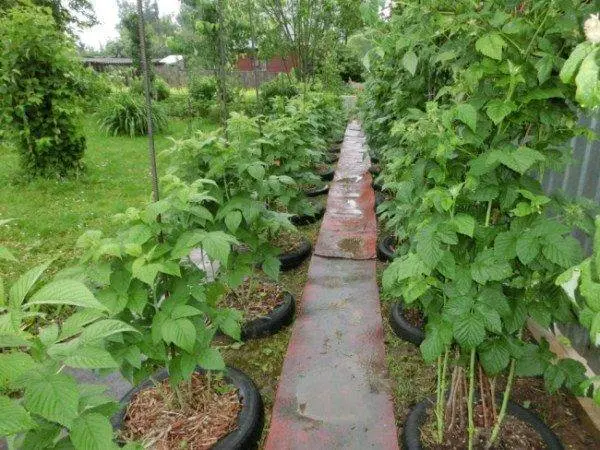Contents
One of the most delicious summer berries is raspberries. Its appearance, smell, color, shape and size are familiar to everyone from childhood. Initially, raspberries were harvested in the forests. Then the plant was cultivated, a huge number of garden varieties were bred. Today, on almost any personal plot, you can find bushes of various types of plants, among which there are rare innovative developments of scientists. One of the interesting and favorite varieties of gardeners is the Indian Summer raspberry.
Features of raspberry bushes and berries “Indian Summer”

The raspberry variety “Indian Summer” is the first remontant type of garden bushes, the branches of the fruit plant rise to 1,5-2 meters. The difference between the variety is that the gardener can pinch the top, reducing the spreading of the crown. The leaves do not cover the fruits, allowing you to see the entire crop. The shape is quite large, embossed and dark green. The creator of the variety is Professor I. Kazakov. He crossed two developments of scientists: Kostinbrodsky and Kuzmin’s News. The breeder took the best qualities, added stability, duration and gradual ripening of fruits to the existing characteristics. The result is the creation of the Indian Summer berry variety.
Raspberries are zoned for cultivation in the conditions of the Central, North Caucasian and Western regions. The variety is not suitable for southern territories, as it does not like drought and hot weather conditions. The berry will not yield a crop even in a cold climate. The variety is frost-resistant, withstands temperatures of 30 degrees. At lower temperatures, the bush dies. Raspberry roots can be covered with snow and special structures.
- The shape of the raspberry fruit is oval, oblong.
- Weight is small (3-3,5 grams).
- The color is dark crimson.
Most of the crop is formed at the top of the branches. The fruits are easily removed from the stem, retain integrity and attractiveness. From one raspberry bush you can collect up to 3 kg of berries. To get a crop twice a season, plants of different ages are kept on the site: one- and two-year-olds. The first harvest will begin in June, maturation will last until early October, the Indian summer season. If you deal only with one-year-olds, the crop will ripen later – by August, but there will be more of it, the fruits are riper and tastier.
Care for the bushes “Indian Summer”

Raspberry “Indian Summer” according to the description of care is similar to the work on growing other varieties of berry bushes. To get good fruits, a rich harvest, you need to know and follow a number of simple rules:
- Raspberries love sunlit places. For planting, it is advised to choose the southern and illuminated part of the site.
- Moisture-loving plant requires constant watering.
- There should not be much moisture so that the roots do not rot. Oversaturation of water can lead to waterlogging of the soil and death of the plant.
- The soil under the plant should be loosened, weeds removed.
- It is recommended to constantly fertilize the land with humus, mineral or organic fertilizers.
During the growth period, excess shoots are removed from the Indian Summer raspberry bush. On the remaining stems and shoots, the fruits will be larger. To avoid infection of the plant, it is advised to regularly loosen the soil, allowing air to reach the roots. Raspberries should not be allowed to grow, forming continuous dense thickets. Harvest can be used fresh, for the preparation of home-made preparations: compotes, jams, marmalades. Varietal raspberry is a medicinal berry. During a cold, people who consume raspberry products experience a decrease in temperature, increased sweating.
Planting and propagating varieties
It is recommended to plant seedlings of a varietal plant in the spring, when the weather becomes warm. Another landing period is autumn, before the onset of cold weather. Young shoots of raspberries will be able to take root and bear fruit already in the planting season. The work requires a competent horticultural approach. The amount of the Indian Summer raspberry crop, the taste and quality of the berries will depend on the correctness of the actions.
- First you need to prepare recesses measuring 50×50 cm. The distance between the recesses is at least 1m.
- By placing the seedlings in a recess, the roots are carefully parted to the sides, and the buds are left on the surface.
- The soil in the pit is fertilized with peat or humus. Only nutrient-rich land will give a high yield.
- After completion of work, approximately a bucket of water is poured under each plant.

Every year at the end of autumn and after the last berries are harvested, pruning is carried out. At this stage, all shoots and stems that are two years old are removed. If some of the branches cannot be cut, then exactly the same pruning can be repeated in the spring. The stronger the shoots on the stem are cut off, the later the crop will appear, the healthier and tastier the fruits will be. In addition, the shape of the berries will change – they will become more elongated.
The reproduction of the remontant raspberry variety “Indian Leto” is carried out by a method peculiar to this species. Basal shoots are left to grow for the next season, the remaining branches are removed. The formation of a raspberry bush is repeated every year.
Reviews
Reviews of gardeners characterize the Indian Summer raspberry variety as tasty and fruitful. The disadvantages include low transportability. Small-sized fruits are taken by the number and time of growth. It’s nice to enjoy fresh, tasty and fragrant berries until the very autumn, which are also healthy. The variety “Indian Summer” is no longer young, but remains popular with gardeners today.









